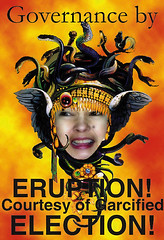The Great Depression: Deja vu all over again
No, it’s not quite the Great Depression in the America — not yet anyway. In the 1930s, unemployment was at 25% compared to only about 6% today. While more layoffs are expected next year, members of the National Association of Business Economists believe unemployment will rise to just around 7%. Even assuming that the US$700 billion bailout fails, economic forecasters estimate the unemployment rate to rise between 10% and 12%, still less than half of the 1930s scenario.
In terms of economic growth, the Great Depression saw the gross domestic product plummet by 13% in 1932. That’s a far cry from the expected 1.1% drop this last quarter of 2008, even assuming the bailout fails to jumpstart the flow of credit. Economists surveyed by CNNMoney.com surmised that in a worst-case scenario the GDP may drop by a maximum of 4%.
What made the 1930s crisis spin out of control was the lack of social safety net programs, including Social Security, unemployment benefits and insurance on people’s bank deposits. In addition, the fact that economic managers now have the benefit of hindsight (thus avoiding policies that directly aggravated the problem, such as the tightening of credit and the closing or protection of domestic markets) makes the specter of another Great Depression less likely.
Prudently allocating hundreds of billions of dollars (in addition to the US$700 bailout) in an active, diverse, and innovative New Deal-type approach to spur the economy will be the extraordinary medicine required to treat a massive heart attack that has now beset the US economy. President-elect Obama’s plan to fund major infrastructure projects and innovation in green technology is not only good in the short term; it will also help the US build its long-term capacity to compete. And creating a generation of new environmentally friendly technologies may be the new industry that will rejuvenate the US economy the way cars and personal computers drove economic prosperity in the past.
I suspect the worse problem America is now facing is not so much the lack of policy solutions to a major macroeconomic downturn but how to deal with one basic economic fundamental: a consumer-driven economy will work only when it’s sustainable — when people spend more than they can afford, then any “prosperity” is a sham and is bound to fall apart like a stack of cards.
Unfortunately, indicators are not exactly good. According to MarketWatch, 43% of Americans spend more than they earn. The average household now carries some US$8,000 to US$10,000 in credit-card debt. Savings is in the negative territory, from an 11% savings rate in 1984.
Only a few years ago Americans were using their homes as a cash cow — assuming that rising home prices would leave them ahead of the game. Now with the housing market tanking and huge chunks of retirement accounts falling off to the ground zero of the financial meltdown, the average American has nothing much to draw from. Those who are about to retire are hit the hardest: a couple who may have painstakingly amassed US$600,000 in retirement money are now left with only around US$360,000, assuming the typical drop of 40% in the equity market since the unraveling of Wall Street last year. Younger people whose time horizons are longer can afford (or like to believe they can afford) to sit it out and expect to recover their investment and then some.
Bottom line: While there are practical macroeconomic solutions to the current credit crisis, Americans need to start spending within their means or any recovery will be artificial and fleeting. How can Americans move from a negative savings to a positive savings territory? I suspect that is the question that should underlie any real solution to America’s biggest economic crisis since the Great Depression. Simply lowering unemployment is clearly not sufficient, as the decline in savings actually occurred in an era when unemployment was historically low. Arguably, the problem boils down to personal values and discipline, which the government can’t really legislate. Ultimately, compelling incentives will have to be provided at the microeconomic level if America is to start mitigating a rather steep economic decline.
In terms of economic growth, the Great Depression saw the gross domestic product plummet by 13% in 1932. That’s a far cry from the expected 1.1% drop this last quarter of 2008, even assuming the bailout fails to jumpstart the flow of credit. Economists surveyed by CNNMoney.com surmised that in a worst-case scenario the GDP may drop by a maximum of 4%.
What made the 1930s crisis spin out of control was the lack of social safety net programs, including Social Security, unemployment benefits and insurance on people’s bank deposits. In addition, the fact that economic managers now have the benefit of hindsight (thus avoiding policies that directly aggravated the problem, such as the tightening of credit and the closing or protection of domestic markets) makes the specter of another Great Depression less likely.
Prudently allocating hundreds of billions of dollars (in addition to the US$700 bailout) in an active, diverse, and innovative New Deal-type approach to spur the economy will be the extraordinary medicine required to treat a massive heart attack that has now beset the US economy. President-elect Obama’s plan to fund major infrastructure projects and innovation in green technology is not only good in the short term; it will also help the US build its long-term capacity to compete. And creating a generation of new environmentally friendly technologies may be the new industry that will rejuvenate the US economy the way cars and personal computers drove economic prosperity in the past.
I suspect the worse problem America is now facing is not so much the lack of policy solutions to a major macroeconomic downturn but how to deal with one basic economic fundamental: a consumer-driven economy will work only when it’s sustainable — when people spend more than they can afford, then any “prosperity” is a sham and is bound to fall apart like a stack of cards.
Unfortunately, indicators are not exactly good. According to MarketWatch, 43% of Americans spend more than they earn. The average household now carries some US$8,000 to US$10,000 in credit-card debt. Savings is in the negative territory, from an 11% savings rate in 1984.
Only a few years ago Americans were using their homes as a cash cow — assuming that rising home prices would leave them ahead of the game. Now with the housing market tanking and huge chunks of retirement accounts falling off to the ground zero of the financial meltdown, the average American has nothing much to draw from. Those who are about to retire are hit the hardest: a couple who may have painstakingly amassed US$600,000 in retirement money are now left with only around US$360,000, assuming the typical drop of 40% in the equity market since the unraveling of Wall Street last year. Younger people whose time horizons are longer can afford (or like to believe they can afford) to sit it out and expect to recover their investment and then some.
Bottom line: While there are practical macroeconomic solutions to the current credit crisis, Americans need to start spending within their means or any recovery will be artificial and fleeting. How can Americans move from a negative savings to a positive savings territory? I suspect that is the question that should underlie any real solution to America’s biggest economic crisis since the Great Depression. Simply lowering unemployment is clearly not sufficient, as the decline in savings actually occurred in an era when unemployment was historically low. Arguably, the problem boils down to personal values and discipline, which the government can’t really legislate. Ultimately, compelling incentives will have to be provided at the microeconomic level if America is to start mitigating a rather steep economic decline.
************************************************************************
 Marvin Bionat is the creator of PhilippineUpdate.com, a news and views site that has served as a virtual platform that promotes various advocacies, including the political empowerment of overseas Filipinos and accountability in government. He wrote the National Bookstore bestseller How to Win (or Lose) in Philippine Elections (Anvil Publishing, 1998) and is now based in the
Marvin Bionat is the creator of PhilippineUpdate.com, a news and views site that has served as a virtual platform that promotes various advocacies, including the political empowerment of overseas Filipinos and accountability in government. He wrote the National Bookstore bestseller How to Win (or Lose) in Philippine Elections (Anvil Publishing, 1998) and is now based in the ************************************************************************

POGB will not sell, exchange, use or allow any 3rd party access to your email for
any other purposes without exception, email exclusively for article updates only.
























0 Speak Out:
Post a Comment